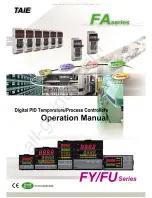
Translated by R.Whitehead 21-1-2012 for my own use
(No liability can be accepted for the result of any errors!)
3 of 4
There is the possibility of doing the setup with the transmitter throttle stick, however,
this is not further explained here. The manual for this is available at
under the download section. Please note that the full functionality is only possible
using ProgCard II.
If during a normal start you accidentally go into the programming mode (turned on
with the stick at full throttle), simply disconnect the battery, move the transmitter to
Stop, and plug the battery back on. Thus you will adjust nothing.
Lipo protection / undervoltage protection:
By constant load voltage adjustment it is possible to fly further with less gas because
the battery recovers at a lower load. However, if the voltage continues to fall, the
motor is switched off.
Over temperature / over-load warning
:
If the speed controller reaches a high temperature during operation, due to
overloading or lack of cooling, after landing or motor stop a warning signal is output.
(3 tones repeating). The motor is not turned off in the air for now! Only when the
temperature reaches a critical threshold is shut off reached.
The part-load operation between half and almost full power is the difficult area for a
controller. Then there is the exposure to increasingly long flight times with Lipos. If
you get repeated temperature warning you need to provide better cooling and/or a
lower current. This display is to be regarded as an overload warning and
not as
normal operating condition
. At high temperatures the components are highly
stressed, leading to a reduction the life span.
You get a better cooling not only by sizeable air intake, but most important is a
slightly larger outlet to avoid heat storage. Lower current can be achieved by a
smaller propeller or 1 cell less in the battery.
Opto-coupler:
The control input has a voltage range from 3v to 9v and thus is compatible with 2s
Lipo.
When using an extra BEC the galvanic separation of the opto-coupler is bypassed,
so any interference is passed to the receiver again. Here we suggest use of our
‘core
ring
’ for subsequent filtering.






















